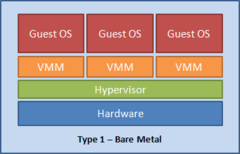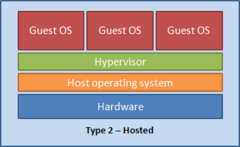Virtual server
To provide students with experience in collaboration, you are warmly invited to join in here, or to leave comments on the discussion page. The anticipated date of course completion is 13 August 2010. One month after that date at the latest, this notice shall be removed. Besides, many other Citizendium articles welcome your collaboration! |
A virtual server is a virtual machine (VM) that is running on top of a physical server. The physical server containing the virtual server is commonly called the host whereas each virtual server contained in the host is referred to as a guest. A virtual server is created through hardware virtualization.
Virtual servers are isolated in their own virtual environment allowing multiple instances to be hosted simultaneously on a single server. Guests on the server can run different applications or tasks, on different operating systems, independently from one another. From example, one virtual server can run as a chat server, another as an FTP server, and another as database server, all of which can run concurrently on a single physical machine. To ensure independence and consistency, the physical server utilizes a hypervisor whose role is to monitor the states of each guest. To server users, this appears as if each virtual server is a unique physical device thus maximizing the resources and processing-power of a single physical server. Downtime during server maintenance is also minimized since virtual servers can easily be transferred or migrated from one physical server to another given that both servers are running on the same processor manufacturers.
History
Technology
Virtual servers are computers which run in a virtualized environment knowingly or unknowingly. Virtualized environment is created by abstracting hardware level from the operating systems (OS). This level of abstraction occurs by implementing a thin layer of software between the physical hardware of the computers and the operating system on top of it.
Operating systems that are running in a virtualized environment is commonly called Guest OSs and the OS which provides the bases of virtualized environment is called an Host OS.
Hypervisor
Hypervisor also known as Virtual Machine Monitor (VMM) is the software which provides the thin layer of abstracted hardware to the guest operating systems. In most circumstances, guest OSs communicates with the hypervisor layer which translates guest OSs instructions to hardware instructions which operates the physical server.
There are two types of hypervisors.
- Type 1 - Bare metal: Hypervisors which runs directly on top of the hardware. Type 1 hypervisors usually built on top of micro-kernel which controls both the hardware and the guest OSs. Examples are Xen Hypervisor, VMware GSX, Microsoft Hyper-V.
- Type 2 - Hosted: Hypervisors running on top of a host OS. Host OS controls the hardware and the hypervisor layer sits on top of the hosted OS which guest OSs running as processes within the host OS. Examples are Virtual PC, VMware Workstation, VirtualBox, Parallels Desktop for Mac.
Full virtualization
Paravirtualization
Hypervisor is a level of virtualization that sits above the hardware layer, intercepting hardware calls from the Operating Systems.
Few links for technology section.
http://en.wikipedia.org/wiki/Hypervisor
http://www.xen.org/products/xenhyp.html
http://learn.iis.net/page.aspx/118/shared-hosting-configuration#envarch
http://www.youtube.com/watch?v=1YtRukUeg04


